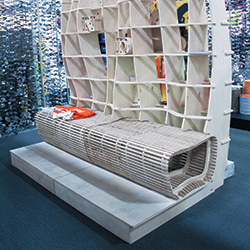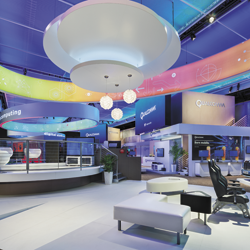|
exhibitor q&a
Help!
CARPET CONSIDERATIONS

ILLUSTRATION: MARK FISHER
Q.
We're about to purchase carpet for our new booth, but the choices seem endless. What are the basic differences among various carpet options?A.
AIndeed, there is a multitude of carpet styles and selections from which to choose. But the differences among types of exhibit carpet generally come down to four factors: yarn (e.g., natural and solution-dyed varieties of nylon, polyester, and polypropylene); the quality of the manufacturing process; texture and style (most evident in options such as cut pile, loop pile, velvet, shag, etc.); and face weight (i.e., the weight of the carpet pile, measured in ounces, which affects how thick a carpet feels).Of these variables, your supplier can talk to you about the myriad textures and styles available and show you the price variations among them. Face weight is fairly straightforward: Carpet with a lower face weight uses less yarn and will typically cost less than one with a higher face weight. So let's concentrate on yarn types and pad options, along with an explanation of the manufacturing process. Types of Yarn Yarn is priced depending on how it's colored and processed. Nylon has been around since the early 1960s and was one of the first yarns designed for the carpet industry. To color it, manufacturers first used piece dyeing, where the dye is applied by passing a continuous piece of carpet through a hot dye solution. This same process can be applied to "natural" (i.e., white, undyed) polyester yarns, which became popular starting in the 1970s. However, around 1990, solution-dyed nylon changed the industry. The most widely used yarn today, solution-dyed nylon is produced by extruding the color into the actual fiber of the yarn (as opposed to moving an entire piece through a machine to color it). Since the color, in effect, becomes one with the yarn, the process makes the resulting carpet cleaner-friendly and bleach-resistant, and it cuts down on the chemicals used in production. Solution-dyed polyester and polypropylene yarns were developed around 2000. (Polypropylene yarn is made from recycled plastic that is melted and extruded into yarn fiber.) These were primarily for the residential flooring market, but in the past three to five years they've made their way into the commercial and hospitality market segments as well. Today, nylon remains the most widely used yarn in the carpet industry because of its longer-wear performance and styling and dyeing options. Polyester is the second-most popular, mainly due to advancements in extrusion technology. In terms of cost, the same yarn can be priced many different ways, depending on how it's processed (e.g., twisted, twisted and heat set, air entangled, etc.) On average, solution-dyed polypropylene is the least expensive, followed by solution-dyed polyester, natural polyester, natural nylon, and solution-dyed nylon. Bottom line: The advantage of any solution-dyed yarn is its cleanability and high-performance colorfastness. The disadvantage is that it comes in limited colors, but there are still hundreds of hues available. On the other hand, the main advantage of natural nylon and natural polyester yarns is unlimited color choices; plus, you can produce small yardages given the dye process. That's because dyeing the yarn itself is a much easier and thus more cost-effective process than dyeing a whole piece of carpet. Polypropylene's major advantage is its low cost; however, it will take less wear and tear than most other options. Padding Choices Carpet with comfortable padding is a great way to roll out the welcome mat for your visitors, and it can convey a sense of quality and luxury the moment someone steps into your exhibit space. Overall, rebond is the lowest-cost and least-durable padding option. Rebond is formed by combining recycled pieces of foam that have been chopped up and shredded into one solid piece. Traditional 4-pound rebond padding will improve the comfort of the carpet in your booth space, but 6-pound is usually well worth the additional investment for many exhibitors. Another option is polyurethane, which is basically a high-cushion foam that can increase a carpet's comfort and longevity. While it'll typically run you triple the cost of 6-pound rebond padding, it will last up to six times longer. And from an installation perspective, when polyurethane is cut, it leaves a straight, clean edge, which can make running cords and electrical a bit easier. Selection Criteria With a basic knowledge of carpet and pad types under your belt, you can then turn your attention to choosing the best combination of each to fit your needs and objectives So here are a few critical considerations for the selection process. Aesthetics – What style of carpet would best fit the look and feel of your exhibit space? For example, are you going for a sophisticated, high-end look, or are you trying to create a warm, comfortable atmosphere to encourage attendees to linger. For a high-end option, choose a carpet with a heavier face weight, perhaps something in the 50-ounce range, and opt for polyurethane or 6-pound rebond to create a sense of luxury. For a cozy or trendy vibe, consider an option like shag with a 6-pound rebond to support an environment that feels plush, comfortable, and worthy of an extended stay. Environment – Where will the carpet will be used? If it'll sit atop venue carpet, then padding is less important and perhaps unnecessary. But if the base is concrete, quality padding will be a blessing for tired feet and can extend the life of your carpet. In addition, consider the amount of foot traffic you anticipate. You want quality carpet that can withstand the demands of trade show traffic without fuzzing or shedding. Frequency – If you plan to use your exhibit carpet just once or twice, a lower-cost pick may meet your needs. If you'll trot it out multiple times, however, you'll get more return on your investment by purchasing a durable, high-quality carpet with a face weight of 26 ounces or more. This concept applies to padding, too. If you want to use the padding frequently throughout the year, polyurethane will be a more durable option than rebond. Last Words As a final note, some exhibitors consider simply buying their own carpet at a retailer instead of purchasing it through a firm that specializes in exhibit carpet. Keep in mind that quality exhibit carpet is designed for the unique demands of exhibiting (e.g., high traffic, shipping, storage, movement, etc.). Plus, if you purchase from an exhibit-industry supplier, your carpet will be precut to the size you need. Compared to a retail-store purchase, this offers you convenience as well as cost savings, because you don't have to pay for the carpet to be cut – or for carpet you don't actually need. In addition, retail carpet offers fewer choices of styles and colors. As you originally indicated, carpet options vary widely. But given the aforementioned info, you should be well armed with basic knowledge as well as style and aesthetic preference considerations, enabling you to select the carpet that best fits your program's needs and budget. — James Zacharias, vice president of sales, Brumark, an Exploring Inc. company, Atlanta
Help Wanted Send your tough questions about exhibiting to Linda Armstrong, larmstrong@exhibitormagazine.com.
|
|
|
||||||||||||||||||||||||||||
|
|
||||||||||||||||||||||||||||
|
TOPICS Measurement & Budgeting Planning & Execution Marketing & Promotion Events & Venues Personal & Career Exhibits & Experiences International Exhibiting Resources for Rookies Research & Resources |
MAGAZINE Subscribe Today! Renew Subscription Update Address Digital Downloads Newsletters Advertise |
FIND IT Exhibit Producers Products & Services All Companies Get Listed |
EXHIBITORLIVE Sessions Exhibit Hall Exhibit at the Show Registration |
ETRAK Sessions Certification F.A.Q. Registration |
EDUCATION WEEK Overview Sessions Hotel Registration |
CERTIFICATION The Program Steps to Certification Faculty and Staff Enroll in CTSM Submit Quiz Answers My CTSM |
AWARDS Exhibit Design Awards Portable/Modular Awards Corporate Event Awards Centers of Excellence |
NEWS Associations/Press Awards Company News International New Products People Shows & Events Venues & Destinations EXHIBITOR News |
||||||||||||||||||||
|
||||||||||||||||||||||||||||






